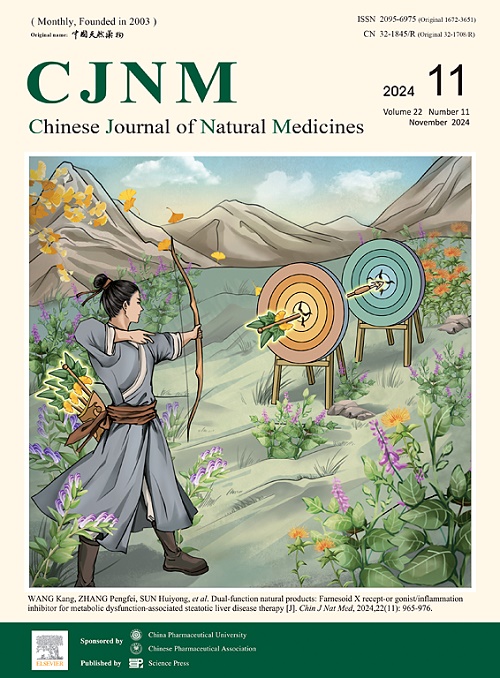Loganin inhibits the ROS-NLRP3-IL-1β axis by activating the NRF2/HO-1 pathway against osteoarthritis
IF 4
2区 医学
Q1 INTEGRATIVE & COMPLEMENTARY MEDICINE
引用次数: 0
Abstract
Loganin (LOG), a bioactive compound derived from Cornus officinalis Siebold & Zucc, has been understudied in the context of osteoarthritis (OA) treatment. In this study, we induced an inflammatory response in chondrocytes using lipopolysaccharide (LPS) and subsequently treated these cells with LOG. We employed fluorescence analysis to quantify reactive oxygen species (ROS) levels and measured the expression of NLRP3 and nuclear factor erythropoietin-2-related factor 2 (NRF2) using real-time quantitative polymerase chain reaction (qRT-PCR), Western blotting, and immunofluorescence (IF) techniques. Additionally, we developed an OA mouse model by performing medial meniscus destabilization (DMM) surgery and monitored disease progression through micro-computed tomography (micro-CT), hematoxylin and eosin (H&E) staining, safranin O and fast green (S&F) staining, and immunohistochemical (IHC) analysis. Our results indicate that LOG significantly reduced LPS-induced ROS levels in chondrocytes, inhibited the activation of the NLRP3 inflammasome, and enhanced NRF2/heme oxygenase 1 (HO-1) signaling. In vivo, LOG treatment mitigated cartilage degradation and osteophyte formation triggered by DMM surgery, decreased NLRP3 expression, and increased NRF2 expression. These findings suggest that LOG has a protective effect against OA, potentially delaying disease progression by inhibiting the ROS-NLRP3-IL-1β axis and activating the NRF2/HO-1 pathway.
罗加宁通过激活 NRF2/HO-1 通路抑制 ROS-NLRP3-IL-1β 轴,防治骨关节炎
Loganin(LOG)是从山茱萸(Cornus officinalis Siebold & Zucc)中提取的一种生物活性化合物,在骨关节炎(OA)治疗方面的研究一直不足。在这项研究中,我们使用脂多糖(LPS)诱导软骨细胞产生炎症反应,然后用 LOG 处理这些细胞。我们采用荧光分析量化活性氧(ROS)水平,并使用实时定量聚合酶链反应(qRT-PCR)、Western 印迹和免疫荧光(IF)技术测量了 NLRP3 和核因子促红细胞生成素-2 相关因子 2(NRF2)的表达。此外,我们还通过内侧半月板失稳(DMM)手术建立了一个 OA 小鼠模型,并通过显微计算机断层扫描(micro-CT)、苏木精和伊红(H&E)染色、黄蓍素 O 和快绿(S&F)染色以及免疫组化(IHC)分析监测疾病进展。我们的研究结果表明,LOG能明显降低LPS诱导的软骨细胞中的ROS水平,抑制NLRP3炎性体的活化,并增强NRF2/血红素加氧酶1(HO-1)信号传导。在体内,LOG治疗减轻了DMM手术引发的软骨退化和骨质增生的形成,降低了NLRP3的表达,增加了NRF2的表达。这些研究结果表明,LOG对OA具有保护作用,可能通过抑制ROS-NLRP3-IL-1β轴和激活NRF2/HO-1通路来延缓疾病进展。
本文章由计算机程序翻译,如有差异,请以英文原文为准。
求助全文
约1分钟内获得全文
求助全文
来源期刊

Chinese Journal of Natural Medicines
INTEGRATIVE & COMPLEMENTARY MEDICINE-PHARMACOLOGY & PHARMACY
CiteScore
7.50
自引率
4.30%
发文量
2235
期刊介绍:
The Chinese Journal of Natural Medicines (CJNM), founded and sponsored in May 2003 by China Pharmaceutical University and the Chinese Pharmaceutical Association, is devoted to communication among pharmaceutical and medical scientists interested in the advancement of Traditional Chinese Medicines (TCM). CJNM publishes articles relating to a broad spectrum of bioactive natural products, leading compounds and medicines derived from Traditional Chinese Medicines (TCM).
Topics covered by the journal are: Resources of Traditional Chinese Medicines; Interaction and complexity of prescription; Natural Products Chemistry (including structure modification, semi-and total synthesis, bio-transformation); Pharmacology of natural products and prescription (including pharmacokinetics and toxicology); Pharmaceutics and Analytical Methods of natural products.
 求助内容:
求助内容: 应助结果提醒方式:
应助结果提醒方式:


